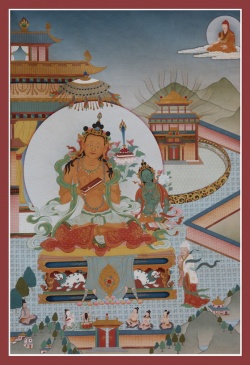Manjushri Yashas
in 176 BCE, King Manjushri Yashas gathered the religious leaders of Shambhala, specifically the brahman wise men, to give them predictions and a warning. Eight hundred years in the future, namely in 624 CE, a non-Indic religion will arise in Mecca. Because of a lack of unity among the brahmans’ people and laxity in following correctly the injunctions of their Vedic scriptures, many will accept this religion, far in the future, when its leaders threaten an
invasion. To prevent this danger, Manjushri Yashas united the people of Shambhala into a single “vajra-caste” by conferring upon them the Kalachakra empowerment. By his act, the king became the First Kalki – the First Holder of the Caste. He then composed The Abridged Kalachakra Tantra, which is the version of The Kalachakra Tantra that is presently extant.
The Sanskrit term for non-Indic here is mleccha (Tib. lalo), meaning someone who speaks incomprehensibly in a non-Sanskrit tongue. Hindus and Buddhists alike have applied it to all foreign invaders of North India, starting with the Macedonians and Greeks at the time of Alexander the Great. The other major Sanskrit term used is tayi, which derives from the Persian term for Arabs, used, for instance, in reference to the Arab invaders of Iran in the mid-seventh century CE.
Manjushri Yashas (Tib. Rigdan Tagpa) is said to have been born in 159 BC and ruled over a kingdom of 300,510 followers of the Mlechha (Yavana or "western") religion, some of whom worshiped the sun. He is said to have expelled all the heretics from his dominions but later, after hearing their petitions, allowed them to return. For their benefit, and the benefit of all living beings, he explained the Kalachakra teachings. In 59 BC he abdicated his throne to his son, Puṇdaŕika, and died soon afterwards, entering the Sambhoga-káya of Buddhahood.
According to tradition, Buddha taught The Kalachakra Tantra in Andhra, South India, in 880 BCE, to the visiting King of Shambhala, Suchandra, and his entourage. King Suchandra brought the teachings back to his northern land, where they have flourished ever since. Seven generations of kings after Suchandra, in 176 BCE, King Manjushri Yashas gathered the religious leaders of Shambhala, specifically the brahman wise men, to give them predictions and a warning. Eight hundred years in the future,
namely in 624 CE, a non-Indic religion will arise in Mecca. Because of a lack of unity among the brahmans’ people and laxity in following correctly the injunctions of their Vedic scriptures, many will accept this religion, far in the future, when its leaders threaten an invasion. To prevent this danger, Manjushri Yashas united the people of Shambhala into a single “vajra-caste” by conferring upon them the Kalachakra empowerment. By his act, the king became the First Kalki – the First Holder of the Caste. He then composed The Abridged Kalachakra Tantra, which is the version of The Kalachakra Tantra that is presently extant.
